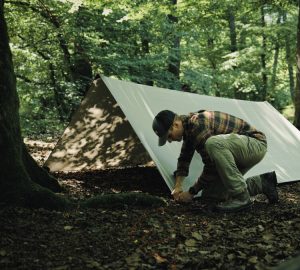A tarp is much more than only the “light” version of a tent: Simple handling and robust materials make it a faithful companion, not only on tours of several days. Mostly we love it as a “roof” to protect us from all weathers that at the same time allows outdoor enthusiasts the crowning highlight of sleeping (almost) under the stars. The tarp, however, can also provide a valuable service at home in your garden.
A tarp is really nothing more than a simple sheet in waterproof material with a spanning eye at each corner and tensioning loops along its seams. On longer tours, because of its uncomplicated, flexible and versatile handling and low weight it can be an alternative to a tent or provide additional comfort, for example, as a protection against either sunshine or rain, where a group of people want to get together.
It can be set up by spanning it with the aid of ropes and special poles or it can be attached to trees or branches. It can also be used as a comfortable and spacious awning at the entrance to a tent. A tarp provides a waterproof place to sleep for all those who want to enjoy spending a night at one with nature.
A tarp can also be used as a sail in a kayak; it prevents your backpack getting wet when crossing a river. When spanned over a hammock it becomes an outdoor bed canopy under which you can enjoy a few relaxing hours under starry skies. Tarps can serve as cover sheets for your backpacks or bicycles.
In fact there are no limits to creativity in possible uses for a tarp – provided that you always have enough ropes and tent pegs included in your gear!
The tarp is useful not only on tour: On the beach, during a picnic in the open air or even in the garden (for example, erected above a children’s sandpit) it protects from direct sun – or of course also from rain, which, as we know, can soon put an end to a party in the garden.
One tarp is not the same as another tarp – it depends on the material
Tatonka tarps are made in 185T polyester PU with fourfold PU finish and with a water head of 8,000 mm. They are lightweight, the fabric does not take up water and therefore does not stretch. The polyester fabric is UV-resistant and colorfast. It is also used in the manufacture of the proven Tatonka tents as a reliable outer material.
For its tarps of the TC series Tatonka uses the cotton blend fabric 60/35 polycotton, with inner side two-layer PU finish and with a long life on the grounds of its good UV stability. With a water head of around 1,300 mm, this material is not waterproof as specified by DIN but the cotton swells when damp and thus makes the fabric watertight.
Tarps in cotton blend fabrics, compared with those of all-round tarps in polyester, are quite heavy, such that they are less suitable for tours in the wilderness with only very little gear. They are, however, ideal for camping holidays, even in warmer regions: Even at high temperatures the air under the treated cotton tarps remains agreeable.
Outdoor equipment needs to be taken care of
The correct care of the materials can extend the life span and robustness of outdoor equipment – here are the three most important tips for gentle but effective cleaning of the tarp (the tips also apply to treatment of the tent):
- Dampness can attack the coating so always allow your tarp to dry completely before packing it away. Even though it has not rained, there is still moisture caused by condensation. Your tarp should therefore be allowed to dry after every tour.
- Never put your tarp in the washing machine. It should be cleaned with a simple, mild soap solution. Never use chemical cleaning agents!
- After drying, fold the tarp together loosely and store in a pack sack. It is recommended that you do not always fold the tarpaulin in the same way as this repeated strain along the same folds could eventually cause damage to the material.
Learn how to use your Tatonka tarp in different ways in our next article.







